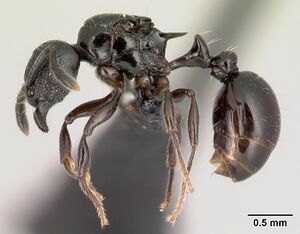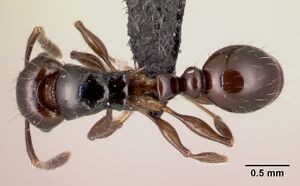Tetramorium valky
| Tetramorium valky | |
|---|---|

| |
| Scientific classification | |
| Kingdom: | Animalia |
| Phylum: | Arthropoda |
| Class: | Insecta |
| Order: | Hymenoptera |
| Family: | Formicidae |
| Subfamily: | Myrmicinae |
| Tribe: | Crematogastrini |
| Genus: | Tetramorium |
| Species: | T. valky |
| Binomial name | |
| Tetramorium valky Hita Garcia & Fisher, 2012 | |
Restricted to lowland rainforest habitats at elevations of 10 to 600 m where it appears to live in leaf litter and lower vegetation.
Identification
A member of the Tetramorium marginatum-species group
Hita Garcia and Fisher (2012) - Tetramorium valky can be well differentiated from the other species group members by the following combination of characters: head longer than wide to as long as wide (CI 92 - 100); mesosoma strongly marginate from sides to dorsum; petiolar node in profile triangular cuneiform to squamiform, usually strongly anteroposteriorly compressed dorsally, sometimes whole node strongly anteroposteriorly compressed; mesosomal dorsum completely unsculptured, smooth, and shining; abundant hairs on mesosomal dorsum not restricted to lateral margins; body of dark brown to black colour.
One aspect of intraspecific variation merits particular mention. The petiolar node is usually markedly triangular cuneiform in lateral view with a strongly anteroposteriorly compressed dorsum. This is the case for almost all of the examined material. Nonetheless, in the few available specimens from Ranomafana, most of the node is anteroposteriorly compressed, causing it to look squamiform and very thin. This difference, however, is not sufficient to justify the heterospecificity of these specimens. Instead we consider this to be intraspecific variation.
Keys including this Species
Distribution
Distributed throughout eastern Madagascar from Mandena and St. Luce in the south to Ambanizana and the type locality Montagne d'Akirindro in the north. (Hita Garcia and Fisher 2012)
Latitudinal Distribution Pattern
Latitudinal Range: -15.2883° to -24.95167°.
| North Temperate |
North Subtropical |
Tropical | South Subtropical |
South Temperate |
- Source: AntMaps
Distribution based on Regional Taxon Lists
Malagasy Region: Madagascar (type locality).
Distribution based on AntMaps
Distribution based on AntWeb specimens
Check data from AntWeb
Countries Occupied
| Number of countries occupied by this species based on AntWiki Regional Taxon Lists. In general, fewer countries occupied indicates a narrower range, while more countries indicates a more widespread species. |

|
Estimated Abundance
| Relative abundance based on number of AntMaps records per species (this species within the purple bar). Fewer records (to the left) indicates a less abundant/encountered species while more records (to the right) indicates more abundant/encountered species. |

|
Biology
Castes
Images from AntWeb
   
| |
| Queen (alate/dealate). Specimen code casent0163232. Photographer Erin Prado, uploaded by California Academy of Sciences. | Owned by CAS, San Francisco, CA, USA. |
   
| |
| Paratype of Tetramorium valky. Worker. Specimen code casent0235220. Photographer Will Ericson, uploaded by California Academy of Sciences. | Owned by CAS, San Francisco, CA, USA. |
   
| |
| Holotype of Tetramorium valky. Worker. Specimen code casent0496394. Photographer Erin Prado, uploaded by California Academy of Sciences. | Owned by CAS, San Francisco, CA, USA. |
Nomenclature
The following information is derived from Barry Bolton's Online Catalogue of the Ants of the World.
- valky. Tetramorium valky Hita Garcia & Fisher, 2012: 108, figs. 128, 133, 135, 153-155 (w.) MADAGASCAR.
Unless otherwise noted the text for the remainder of this section is reported from the publication that includes the original description.
Description
Worker
HL 0.62 - 0.81 (0.73); HW 0.58 - 0.80 (0.71); SL 0.48 - 0.63 (0.57); EL 0.14 - 0.19 (0.17); PH 0.31 - 0.39 (0.36); PW 0.44 - 0.61 (0.54); WL 0.77 - 0.99 (0.90); PSL 0.24 - 0.41 (0.34); PTL 0.06 - 0.11 (0.08); PTH 0.28 - 0.39 (0.34); PTW 0.21 - 0.32 (0.27); PPL 0.16 - 0.27 (0.23); PPH 0.25 - 0.39 (0.32); PPW 0.22 - 0.36 (0.31); CI 92 - 100 (96); SI 78 - 84 (81); OI 23 - 26 (24); DMI 57 - 63 (60); LMI 39 - 43 (40); PSLI 39 - 52 (46); PeNI 46 - 54 (50); LPeI 16 - 31 (24); DPeI 237 - 500 (336); PpNI 48 - 64 (57); LPpI 62 - 81 (72); DPpI 120 - 148 (133); PPI 102 - 124 (114) (15 measured).
Head longer than wide to as long as wide (CI 92 - 100). Anterior clypeus medially impressed. Frontal carinae well developed, ending between posterior eye margin and posterior head margin. Antennal scrobes faint to absent. Antennal scapes short to moderate, not reaching posterior head margin (SI 78 - 84). Eyes moderate to large (OI 23 - 26). Mesosomal outline in profile moderately convex, strongly marginate from lateral to dorsal mesosoma; promesonotal suture absent; metanotal groove present but weak; mesosoma comparatively high, compact, and stout (LMI 39 - 43). Propodeal spines very long, spinose, and acute (PSLI 39 - 52); propodeal lobes small and broadly triangular. Petiolar node in profile triangular cuneiform to squamiform, usually strongly anteroposteriorly compressed dorsally, approximately 3.2 to 6.3 times higher than long (LPeI 16 - 31), anterior and posterior faces usually not parallel, anterodorsal margin generally situated higher than posterodorsal, dorsum distinctly tapering backwards posteriorly, sometimes whole node strongly anteroposteriorly compressed, anterior and posterior faces almost parallel and node noticeably squamiform; node in dorsal view extremely transverse, between 2.3 to 5 times wider than long (DPeI 237 - 500). Postpetiole in profile approximately rounded and weakly anteroposteriorly compressed, approximately 1.2 to 1.6 times higher than long (LPpI 62 - 81), in dorsal view approximately 1.2 to 1.5 times wider than long (DPpI 120 - 148). Postpetiole in profile usually appearing as voluminous as petiolar node, in dorsal view weakly wider than petiolar node (PPI 102 - 124). Mandibles with distinct longitudinal sculpture, sometimes weak, but generally present; clypeus mostly unsculptured, smooth, and shining, few short rugulae or traces of rugulae present; cephalic dorsum between frontal carinae with six to nine longitudinal rugae or rugulae, median ruga usually shorter than frontal carinae and diverging approximately at eye level into two rugae running to posterior clypeal margin, remaining rugulae generally of same length as frontal carinae, often broken and shorter; lateral and ventral head with longitudinal sculpture, especially anteriorly, posteriorly only weakly sculptured or unsculptured. Ground sculpture on head usually faint to absent, sometimes moderately reticulate-punctate. Mesosoma laterally mostly unsculptured, weak sculpture present posteriorly; dorsal mesosoma completely unsculptured, smooth, and shiny. Waist segments and gaster completely unsculptured, smooth, and shiny. All dorsal surfaces of body with abundant, long, erect pilosity, hairs on mesosomal dorsum not restricted to lateral margins. Body of uniform dark brown to black colour.
Type Material
Holotype worker, MADAGASCAR, Toamasina, Montagne d'Akirindro 7.6 km 341° NNW Ambinanitelo, 15.2883 S, 49.5483 E, 600 m, rainforest, ex rotten stick on ground, collection code BLF08376, 17.-21.III.2003 (B.L Fisher, C. Griswold et al.) (California Academy of Sciences: CASENT0496394). Paratypes, seven workers with same data as holotype (CASC: CASENT0496395; CASENT0496396; CASENT0496397); seven workers with same data as holotype except sampled from sifted litter (leaf mold, rotten wood) and collection code BLF08250 (CASC: CASENT0039323; CASENT0039384; Museum of Comparative Zoology: CASENT0039325; Musee d'Histoire Naturelle Genève: CASENT0039552; Naturhistorisches Museum, Basel: CASENT0039320); one worker with same data as holotype except sampled from yellow pan trap and collection code BLF08255 (The Natural History Museum: CASENT049289); one worker with same data as holotype except sampled from beating low vegetation and collection code BLF08359 (CASC: CASENT0496108); nine workers with same data as holotype except sampled from rotten log and collection code BLF08382 (CASC: CASENT0496369; CASENT0496370; CASENT0496371).
Etymology
The name of the new species is an arbitrary combination of letter. The species epithet is a noun in apposition, and thus invariant.
References
References based on Global Ant Biodiversity Informatics
- Garcia H. F. and B. L. Fisher. 2012. The ant genus Tetramorium Mayr (Hymenoptera: Formicidae) in the Malagasy regiontaxonomy of the T. bessonii, T. bonibony, T. dysalum, T. marginatum, T. tsingy, and T. weitzeckeri species groups. Zootaxa 3365: 1-123

